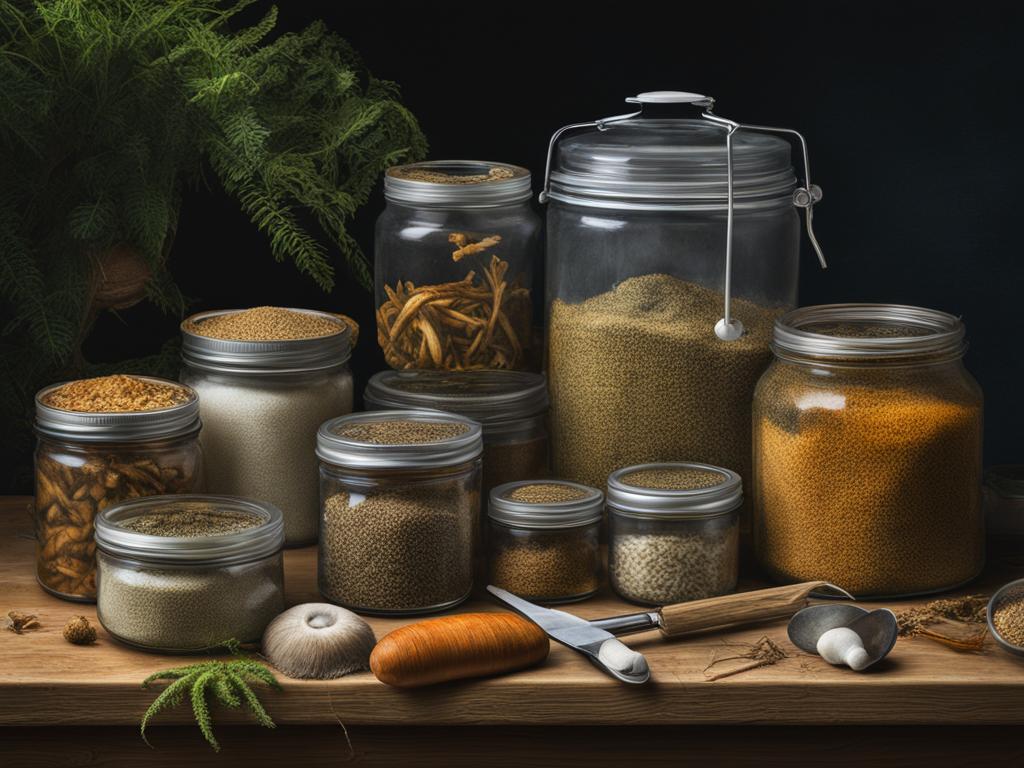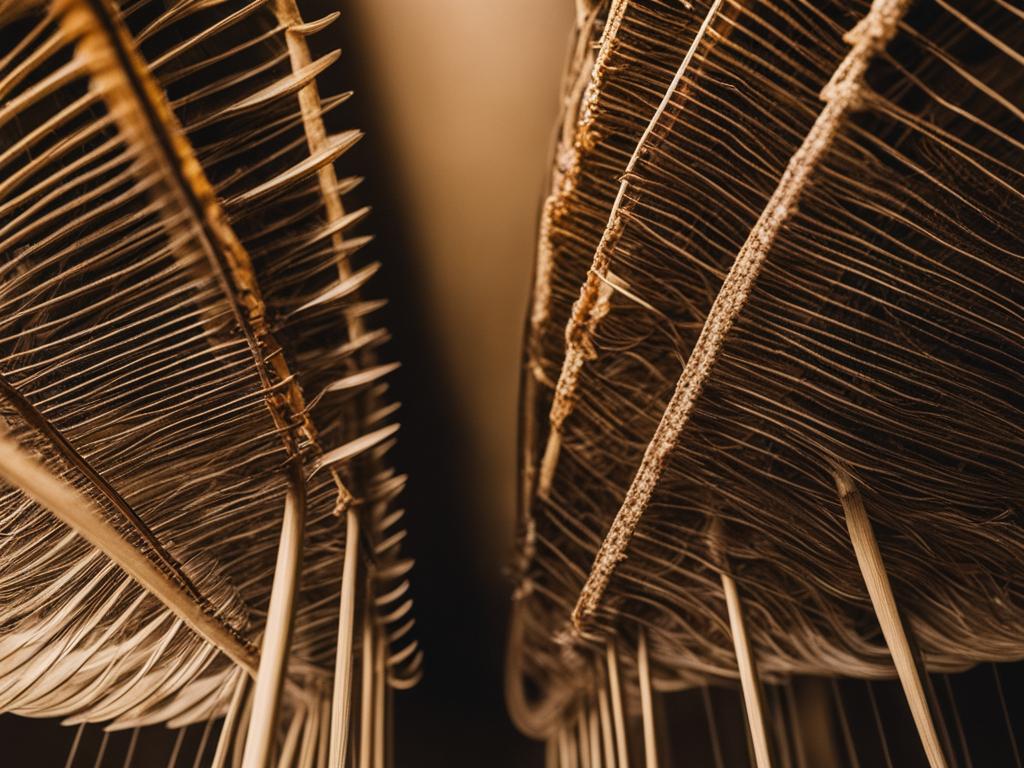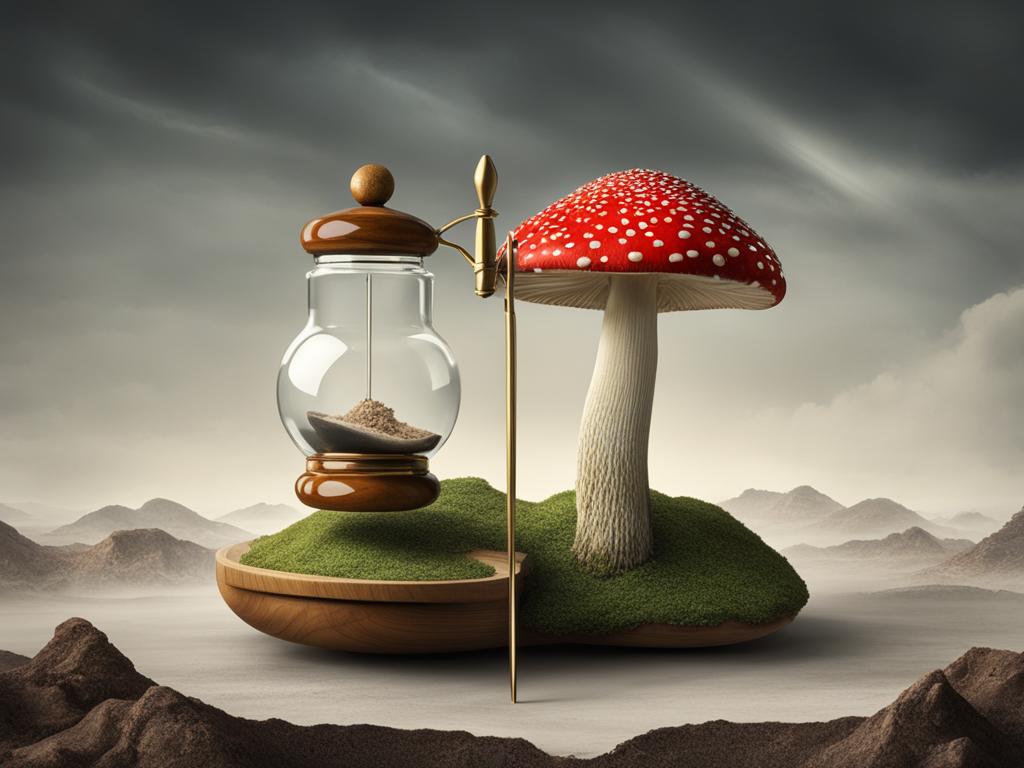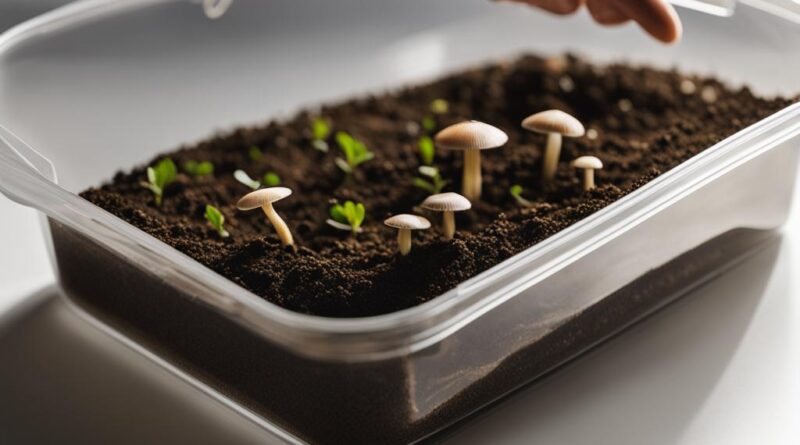Your Guide on How to Grow Psilocybin Mushrooms Safely
Growing psilocybin mushrooms can be a fascinating and rewarding experience. If you’re interested in cultivating these psychedelic fungi safely at home, this comprehensive guide is for you. We’ll provide you with step-by-step instructions and valuable tips to ensure a successful mushroom cultivation journey.
Key Takeaways:
- Learn how to grow psilocybin mushrooms safely at home
- Follow a step-by-step guide for successful cultivation
- Understand the benefits and effects of psilocybin mushrooms
- Gather essential tools and materials for mushroom cultivation
- Maintain optimal growing conditions to promote healthy mushroom growth
Understanding Psilocybin Mushrooms and their Benefits
Psilocybin mushrooms, also known as magic mushrooms, have gained significant popularity for their hallucinogenic properties and potential therapeutic benefits. These mushrooms contain a naturally occurring compound called psilocybin, which is responsible for their psychoactive effects.
When consumed, psilocybin converts to psilocin in the body, binding to serotonin receptors in the brain and altering perception, mood, and cognition. The effects of psilocybin mushrooms range from mild euphoria and sensory enhancement to profound shifts in consciousness and mystical experiences.
Research has shown that psilocybin may have a range of therapeutic benefits. Studies suggest that it may help reduce anxiety and depression, enhance creativity, and promote personal growth and well-being. Psilocybin-assisted therapy is also being investigated as a potential treatment for conditions such as post-traumatic stress disorder (PTSD), addiction, and treatment-resistant depression.
It is important to emphasize that the use of psilocybin mushrooms should be approached with caution and responsibility. The effects can vary widely depending on factors such as dosage, set, and setting. It is crucial to have a safe and supportive environment, adequate knowledge and understanding, and respect for the substance to ensure a positive and beneficial experience.
Getting Started: Essential Tools and Materials
Before you begin your journey of cultivating psilocybin mushrooms, it’s important to gather all the necessary tools and materials. Having the right equipment and supplies will ensure that you have a successful and rewarding cultivation experience. Here are some of the essential tools and materials you will need:
Tools:
- Pressure cooker: Used for sterilizing the substrate and jars.
- Sterilized jars: Containers for holding the substrate and spores.
- Spore syringes: Used for inoculating the jars with the psilocybin mushroom spores.
- Thermometer and hygrometer: Helps monitor and maintain the temperature and humidity levels.
- Spray bottle: Used for misting the growing environment to maintain humidity.
- Gloves and face mask: Essential for practicing proper hygiene and preventing contamination.
Materials:
- Substrate materials: Common options include brown rice flour, vermiculite, and organic grain.
- Grow bags or containers: Provides a suitable environment for mushroom growth.
- Heating pad or mat: Helps maintain a stable temperature for optimal mushroom growth.
- Light source: Indirect light or a low-wattage fluorescent bulb for the early stages of growth.
- Cleaning supplies: Rubbing alcohol, bleach, and paper towels for maintaining cleanliness.
Having all these tools and materials ready before you start will make the cultivation process smoother and increase your chances of success. Remember to always follow proper sterilization techniques and maintain a clean environment to minimize the risk of contamination.

Step-by-Step Cultivation Process
Now that you have gathered all the necessary tools and materials, it’s time to dive into the step-by-step cultivation process of psilocybin mushrooms. This section will guide you through each essential step, ensuring a successful and rewarding cultivation journey.
Step 1: Preparing the Substrate
The first step in the cultivation process is preparing the substrate, which serves as the food source for the mushroom mycelium. Common substrates include brown rice flour, vermiculite, and water. Combine these ingredients in a sterilized container and mix thoroughly. The substrate should have a consistency similar to a moist, crumbly cake.
Once the substrate is prepared, fill sterilized jars with the mixture, leaving some headspace to prevent contamination. Place a layer of dry vermiculite on top of each jar to act as a protective barrier.
Step 2: Inoculating with Spores
After preparing the substrate, it’s time to inoculate it with psilocybin spores. Use a sterile syringe to inject spore solution into the substrate jars through the vermiculite layer. Each jar typically requires around 1-2 milliliters of spore solution. Once the spores are injected, seal the jars with sterile lids or breathable tape.
Step 3: Maintaining Optimal Humidity and Temperature
Proper humidity and temperature levels are crucial for healthy mushroom growth. Keep your cultivation area in a clean and controlled environment. Aim for a humidity level of around 90-95% and a temperature between 70-75°F (21-24°C). Use a hygrometer and thermometer to monitor these conditions regularly, making adjustments as necessary.
To maintain humidity, you can use a spray bottle filled with sterilized water to mist the inside of the cultivation chamber. The substrate should remain moist but not waterlogged. Avoid opening the chamber unnecessarily to prevent fluctuations in humidity and temperature.
Step 4: Preventing Contamination
Preventing contamination is crucial for successful mushroom cultivation. Practice proper hygiene throughout the process, including sterilizing your tools and working in a clean environment. Avoid touching the substrate or jars directly with your hands. Instead, use sterile gloves or tools to handle them.
Be mindful of potential contaminants such as mold, bacteria, and other fungi. If any signs of contamination, such as unusual colors or odors, appear in the substrate or jars, it is best to discard them to prevent the contamination from spreading.
By following these step-by-step instructions, you are on your way to cultivating psilocybin mushrooms successfully. Remember to maintain a clean and controlled environment, monitor humidity and temperature levels, and practice proper hygiene throughout the process. Patience and attention to detail will lead to a rewarding harvest of your own psilocybin mushrooms.
Maintaining Optimal Growing Conditions
Creating and maintaining the ideal growing conditions is crucial for the healthy development of psilocybin mushrooms. By controlling factors such as temperature, humidity, air circulation, and light exposure, you can ensure the successful growth of your mushrooms. Indoor mushroom cultivation techniques offer a range of options for customizing these conditions to meet the specific needs of your mushroom species. Let’s explore some of these techniques in detail:
Using Grow Tents
Grow tents are enclosed spaces designed specifically for indoor cultivation. They provide a controlled environment by regulating factors such as temperature, humidity, and light. The reflective interior of the tent ensures optimal light distribution, while vents allow for proper air circulation. Grow tents are an excellent option for beginners as they offer convenience and ease of use.
Building a Terrarium
A terrarium is another popular option for indoor mushroom cultivation. It involves creating a miniature enclosed ecosystem using a glass container or plastic tub. The terrarium traps moisture, creating a humid environment that promotes mushroom growth. This technique is particularly suitable for species that thrive in high humidity conditions.
Constructing a Grow Chamber
A grow chamber is a custom-built indoor space that allows you to have complete control over the growing conditions. It typically consists of shelves or racks where you can place your mushroom cultivation containers. You can install temperature and humidity controllers, fans, and lighting systems to create the optimal environment for your mushrooms. Building a grow chamber requires more effort and investment but offers maximum flexibility.
Experimenting with different indoor cultivation techniques can help you find the method that works best for you and your specific mushroom species. Remember to monitor the conditions regularly and make adjustments as needed to ensure the continued growth and development of your psilocybin mushrooms.
| Factors | Optimal Range |
|---|---|
| Temperature | 22-25°C (71-77°F) |
| Humidity | 85-95% |
| Air Circulation | Gentle airflow without direct drafts |
| Light Exposure | Indirect light or low-intensity artificial light |
Harvesting and Drying Your Psilocybin Mushrooms
Once your psilocybin mushrooms have reached their maturity, it’s time to harvest and dry them to preserve their potency and extend their shelf life. Harvesting your mushrooms involves carefully plucking the mature mushrooms from the substrate. Gently twist the mushrooms at the base to detach them, taking care to minimize any damage. Avoid using excessive force or pulling on the mushrooms, as this can disrupt the mycelium network.
After harvesting, it’s important to dry your psilocybin mushrooms to remove moisture and prevent spoilage. There are several methods you can use to dry your mushrooms, including using a dehydrator, desiccant, or simply air-drying them in a well-ventilated area. If using a dehydrator, set it to a low temperature (around 95°F-115°F) and place the mushrooms on the trays in a single layer. Drying times can vary, but it typically takes around 24-48 hours for the mushrooms to become cracker-dry.
When air-drying your mushrooms, spread them out on a clean surface or hang them upside down using a string or mesh. Make sure the area is well-ventilated and away from direct sunlight, as exposure to sunlight can degrade the psilocybin content. Keep in mind that the drying process may take longer when air-drying compared to using a dehydrator. The mushrooms should be completely dry to the touch and snap easily when bent.

Drying Psilocybin Mushrooms Methods Comparison:
| Method | Advantages | Disadvantages |
|---|---|---|
| Dehydrator | Fast and efficient drying | Requires an additional piece of equipment |
| Desiccant | Effective in removing moisture | May take longer than a dehydrator |
| Air-drying | Minimal equipment required | Takes the longest to dry |
Once your psilocybin mushrooms are thoroughly dried, store them in an airtight container in a cool, dark, and dry place. A glass jar with a tight-fitting lid works well for storing dried mushrooms. Remember to label the container with the strain and date of harvest for future reference. Properly dried and stored psilocybin mushrooms can maintain their potency for several months to a year, allowing you to enjoy their benefits whenever you choose.
Potential Risks and Precautions in Mushroom Cultivation
Growing mushrooms can be a rewarding and fulfilling experience, but it’s important to be aware of the potential risks involved. By understanding and taking the necessary precautions, you can minimize these risks and ensure a safe and successful mushroom cultivation journey.
Contamination and Proper Sterilization Techniques
One of the main risks in mushroom cultivation is contamination. Contamination can occur if your tools, materials, or growing environment are not properly sterilized. Bacteria, molds, and other microorganisms can disrupt the growth of your mushrooms and potentially render them inedible or unsafe to consume. To prevent contamination, it’s crucial to follow proper sterilization techniques, such as using a pressure cooker to sterilize your jars and working in a clean and sanitized environment.
Identifying and Sourcing Reliable Spores
Another risk in mushroom cultivation is the consumption of unidentified mushrooms. It’s important to be able to correctly identify psilocybin mushrooms and distinguish them from potentially toxic or poisonous varieties. Educate yourself on the different characteristics and features of psilocybin mushrooms, and never consume any mushrooms unless you are absolutely certain of their identity. Additionally, sourcing reliable spores from reputable vendors ensures that you are working with high-quality genetics and reduces the risk of cultivating undesirable or unsafe mushroom strains.
Personal Safety and Responsible Use
It’s essential to prioritize personal safety when cultivating and consuming psilocybin mushrooms. Take the necessary precautions to protect yourself, such as wearing gloves and a mask when handling potentially contaminated materials. Additionally, practice responsible use of psilocybin mushrooms by adhering to recommended dosage guidelines, starting with lower doses if you are inexperienced, and always having a trusted trip sitter present when consuming larger doses. Remember, safety and responsible use are paramount to ensuring a positive and beneficial experience with psilocybin mushrooms.
| Risks of Growing Mushrooms | Precautions for Mushroom Cultivation |
|---|---|
| Contamination from bacteria, molds, etc. | Proper sterilization techniques |
| Consumption of unidentified mushrooms | Identify psilocybin mushrooms accurately |
| Safety hazards during cultivation | Follow personal safety measures |
| Unsafe or improper use of mushrooms | Practice responsible and informed consumption |
Enjoying Psilocybin Mushrooms: Microdosing and Trip Tips
Psilocybin mushrooms offer unique experiences, not only in the form of full psychedelic trips but also through microdosing. Microdosing involves consuming sub-perceptual doses of psilocybin to enhance creativity, focus, and overall well-being without experiencing intense hallucinations. It has gained popularity as a way to integrate the benefits of psilocybin into daily life.
Microdosing Psilocybin Mushrooms
Microdosing involves taking a fraction of a regular dose of psilocybin mushrooms, typically around 0.1 to 0.3 grams. This small amount is not intended to produce a full-blown psychedelic experience but rather to subtly influence cognition and mood. Microdosing is often done following a specific regimen, such as taking one dose every three days or one dose every other day, for an extended period of time.
Advocates of microdosing claim that it can enhance creativity, improve focus and productivity, boost mood, and increase overall well-being. However, it is important to note that the effects of microdosing can vary from person to person. It is advisable to start with the lowest effective dose and carefully observe how it affects you. Consulting with a healthcare professional is recommended before incorporating microdosing into your routine.
Tips for a Safe Psychedelic Trip
If you decide to embark on a full psychedelic trip with psilocybin mushrooms, it is crucial to prioritize safety and set yourself up for a positive experience. Here are some tips for a safe and enjoyable trip:
- Set and setting: Choose a comfortable and familiar environment where you feel safe and secure. Set aside dedicated time for the trip, free from distractions.
- Plan your dosage: Start with a moderate dose and gradually increase it if desired. Keep in mind that the intensity and duration of the trip can vary depending on the dosage.
- Stay hydrated and nourished: It is important to stay hydrated and eat light, nutritious meals before and during the trip.
- Have a trip sitter: Consider having a trusted friend or partner present during the trip to provide support and guidance if needed.
- Practice harm reduction: Avoid combining psilocybin mushrooms with other substances, especially alcohol and drugs. Be aware of potential interactions and risks.
Remember that experiences with psilocybin mushrooms can be highly subjective and are influenced by various factors such as mindset, intention, and environment. It is always recommended to approach psychedelic experiences with respect, caution, and responsible use.
Legal and Ethical Considerations
When engaging in the cultivation of psilocybin mushrooms, it is crucial to be aware of the legal status of these fungi in your country or state. While some jurisdictions have decriminalized or legalized the use of psilocybin mushrooms for medical or recreational purposes, others still consider them illegal. Therefore, it is essential to familiarize yourself with the laws and regulations governing their cultivation and use to ensure compliance and avoid potential legal issues.
Alongside legal considerations, ethical principles should also guide your mushroom cultivation practices. Responsible use, harm reduction, and respecting the natural environment are fundamental ethical considerations to bear in mind. It is important to cultivate and consume psilocybin mushrooms in a manner that promotes safety, wellbeing, and sustainability. By practicing responsible cultivation techniques and following harm reduction strategies, you can minimize potential risks and contribute to a positive and ethical mushroom cultivation community.
“Cultivating and consuming psilocybin mushrooms should always be approached with mindfulness and respect for oneself, others, and the environment.” – Ethical Mushroom Cultivator
Legal Status of Psilocybin Mushrooms
The legal status of psilocybin mushrooms varies worldwide. In some countries, such as Brazil, Jamaica, and the Netherlands, the personal use and cultivation of psilocybin mushrooms are decriminalized or permitted under certain circumstances. Other countries, including the United States, Canada, and the United Kingdom, classify psilocybin mushrooms as illegal substances, with varying degrees of enforcement and penalties for possession, cultivation, and distribution.
Ethical Considerations in Mushroom Cultivation
Mushroom cultivation carries ethical implications that extend beyond legal boundaries. Responsible cultivation practices encompass factors such as sourcing spores from reliable vendors, prioritizing personal and community safety, and adhering to good hygiene practices to minimize contamination risks. Additionally, it is crucial to consider the environmental impact of mushroom cultivation. This includes using sustainable materials, minimizing waste generation, and respecting natural ecosystems that support mushroom growth.
By understanding the legal status of psilocybin mushrooms and embracing ethical considerations, you can engage in mushroom cultivation in a manner that aligns with legal requirements and respects the well-being of individuals, communities, and the environment.

Conclusion
Embarking on the journey of cultivating your own magic mushrooms can be a fulfilling and transformative experience. This beginner’s guide provides you with the essential knowledge and techniques to successfully grow these fascinating fungi.
By following the step-by-step instructions, maintaining optimal growing conditions, and taking necessary precautions, you can ensure healthy mushroom growth. Remember to prioritize safety, education, and responsible use throughout your cultivation process.
With this comprehensive guide as your companion, you are now equipped to dive into the world of growing magic mushrooms. Get ready to witness the wonders of nature unfold before your eyes. Happy cultivating!
FAQ
What are the benefits of psilocybin mushrooms?
Psilocybin mushrooms have various therapeutic benefits, including reduced anxiety, enhanced creativity, and a potential breakthrough treatment for certain medical conditions.
What tools and materials do I need for growing psilocybin mushrooms?
You will need items such as a pressure cooker, sterilized jars, spore syringes, substrate materials, and a controlled environment setup.
What is the cultivation process for psilocybin mushrooms?
The cultivation process involves preparing the substrate, inoculating with spores, maintaining optimal humidity and temperature, and preventing contamination.
How do I create and maintain optimal growing conditions for psilocybin mushrooms?
This includes controlling temperature, humidity, air circulation, and light exposure using techniques such as grow tents, terrariums, or grow chambers.
How do I harvest and dry my psilocybin mushrooms?
Carefully pluck the mature mushrooms from the substrate and dry them using a dehydrator, desiccant, or a well-ventilated area to remove moisture.
What are the potential risks and precautions in mushroom cultivation?
Risks include contamination, improper sterilization techniques, and the consumption of unidentified mushrooms. Precautions include proper hygiene, sourcing reliable spores, and educating yourself on identifying psilocybin mushrooms.
What is microdosing and what are trip tips for psilocybin mushrooms?
Microdosing involves consuming sub-perceptual doses of psilocybin for enhanced creativity and focus. Trip tips include setting and setting, dosage recommendations, and having a trip sitter.
What are the legal and ethical considerations in mushroom cultivation?
It is important to be aware of the legal status of psilocybin mushrooms in your jurisdiction. Ethical considerations include responsible use, harm reduction, and respecting the natural environment.

